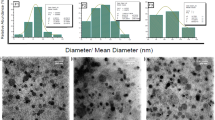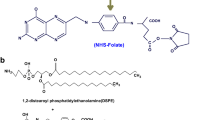Abstract
Ovarian cancer is one of the most fatal gynecologic cancers. In this debut study, dual approach using synergistically active combination of paclitaxel–topotecan (Pac–Top; 20:1, w/w) is investigated with utilization of characteristic features of tumor micro-environment and additionally overexpressed folate receptors (FR-α) to achieve targeting to tumor site. Various liposomes namely liposomes, PEGylated liposomes, and FR-targeted PEGylated liposomes with lipid compositions viz. DPPC:DMPG (85.5:9.5), DPPC:DMPG:mPEG2000–DSPE (85.5:9.5:5), and DPPC:DMPG:mPEG2000–DSPE:DSPE–PEG–folate (85.5:9.5:4.5:0.5), respectively, were developed using thin film casting method. These were nanometric in size around 200 nm. In vitro drug release study showed initial burst release followed by sustained release for more than 72 h at physiological milieu (37 ± 0.5 °C, pH 7.4) while burst release (i.e., more than 90 %) within 5 min at simulated tumor milieu (41 ± 1 °C, pH 4). SRB cytotoxicity assay in OVCAR-3 cell line revealed Pac–Top free (20:1, w/w) to be more toxic (GI50 = 6.5 μg/ml) than positive control (Adriamycin, GI50 = 9.1 μg/ml) and FR-targeted PEGylated liposomes GI50 (14.7 μg/ml). Moreover, florescence microscopy showed the highest cell uptake of FR-targeted PEGylated liposomes so called “smart liposomes” which has not only mediated effective targeting to FR-α but also triggered release of drugs upon hyperthermia.










Similar content being viewed by others
References
Bokkel H, Lane GA (2004) Long-term survival in a phase III, randomised study of topotecan versus paclitaxel in advanced epithelial ovarian carcinoma. Ann Oncol 15:100–103
Burke TG, Gao X (1994) Stabilization of TPT in low pH liposomes composed of distearoylphosphatidyl-choline. J Pharm Sci 83:967–969
Crosasso P, Ceruti M, Brusa P, Arpicco S, Cattel L (2000) Preparation, characterization and properties of sterically stabilized paclitaxel containing liposomes. J Control Release 63:19–30
Dadashzadeh S, Vali AM, Rezaie M (2008) The effect of PEG coating on in vitro cytotoxicity and in vivo disposition of topotecan loaded liposomes in rats. Int J Pharm 353:251–259
Danhier F, Feron O, Preat V (2010) To exploit the tumor microenvironment: passive and active tumor targeting of nanocarriers for anti-cancer drug delivery. J Control Release 148:135–146
Frederick GV et al (2006) A study of variable hydration states in topotecan hydrochloride. J Pharm Biomed Anal 40:1080–1088
Fry DW, White JC, Goldman ID (1978) Rapid separation of low molecular weight solutes from liposomes without dilution. Anal Biochem 90(2):809–815
Gore M et al (2001) Clinical evidence for topotecan-paclitaxel non–cross-resistance in ovarian cancer. J Clin Oncol 19:1893–1900
Guo J, Ping Q, Sun G, Jiao C (2000) Lecithin vesicular carriers for transdermal delivery of cyclosporin. Int J Pharma 194:201–207
Gupta Y, Soni V, Chourasia MK, Jain A, Khare P (2005) Targeted drug delivery to the brain via transferrin coupled liposomes. Drug Deliv Tech 5:66–71
Homesley H, Benigno B, Williams J, Vaccarello L (2002) A phase I study of weekly topotecan and paclitaxel in previously treated epithelial ovarian carcinoma patients. Gynecol Oncol 87:171–177
Huinink WB, Lane SR, Ross GA (2004) Long-term survival in a phase III, randomised study of topotecan versus paclitaxel in advanced epithelial ovarian carcinoma. Ann Oncol 15:100–103
Immordino ML, Dosio F, Cattel L (2006) Stealth liposomes: review of the basic science, rationale, and clinical applications, existing and potential. Int J Nanomedicine 1(3):297–315
Jemal A et al (2008) Cancer statistics. CA Cancer J Clin 58:71–96
Kanwaldeep KG, Sami N, Amal K (2011) Paclitaxel loaded PEG5000–DSPE micelles as pulmonary delivery platform: formulation characterization, tissue distribution, plasma pharmacokinetics, and toxicological evaluation. Eur J Pharm Biopharm 79:276–284
Kastantin M, Ananthanarayanan B, Karmali P, Ruoslahti E, Tirrell M (2009) Effect of the lipid chain melting transition on the stability of DSPE–PEG (2000) micelles. Langmuir 25:7279–7286
Kaye S, Brown R, Gabra H (2011) Emerging therapeutic targets in ovarian cancer. Springer, New York
Kono K, Yoshino K, Takagishi T (2002) Effect of poly(ethylene glycol) grafts on temperature-sensitivity of thermosensitive polymer-modified liposomes. J Control Release 80:321–332
Kudelka AP (1996) Phase II study of intravenous topotecan as a 5-day infusion for refractory epithelial ovarian carcinoma. J Clin Oncol 14:1552–1557
Lasic DD, Papahadjopoulos D (1998) Medical applications of liposomes. Elsevier, Amsterdam
Lee RJ, Low PS (1995) Folate-mediated tumor cell targeting of liposome-entrapped doxorubicin in vitro. Biochim Biophys Acta 1233:136
Loew C, Riske KA, Lamy MT, Seelig J (2011) Thermal phase behavior of DMPG bilayers in aqueous dispersions as revealed by 2H- and 31P-NMR. Langmuir 27:10041–10049
Oyewumi MO, Mumper RJ (2002) Engineering tumor-targeted gadolinium hexanedione nanoparticles for potential application in neutron capture therapy. Bioconjug Chem 13:1328–1335
Pei K, Chih T, Wang A, Wu-Chou S (2011) A liposomal formulation able to incorporate a high content of paclitaxel and exert promising anticancer effect. J Drug Deliv. doi:10.1155/2011/629234
Sharma A, Straubinger RM, Ojima I, Bernacki RJ (1995) Antitumor efficacy of taxane liposomes on a human ovarian tumor xenograft in nude athymic mice. J Pharm Sci 84:1400–1404
Skehn P et al (1990) New colorimetric cytotoxicity assay for anticancer drug screening. Natl Cancer Inst 82:1107
Smet M, Langereis S, Bosch SVD, Grul H (2010) Temperature-sensitive liposomes for doxorubicin delivery under MRI guidance. J Control Release 143:120–127
Straubinger RM, Sharma A, Murray M, Mayhew E (1993) Novel taxol formulations: taxol-containing liposomes. J Natl Cancer Inst Monogr 15:69–78
Tagami T, Ernsting MJ, Li S (2011) Optimization of a novel and improved thermosensitive liposome formulated with DPPC and a Brij surfactant using a robust in vitro system. J Control Release 154:290–297
Vichai V, Kirtikara K (2006) Sulforhodamine B colorimetric assay for cytotoxicity screening. Nat Protoc 1:1112–1116
Weinstein JN, Magin RL, Cysyk RL, Zaharko DS (1980) Treatment of solid L1210 murine tumors with local hyperthermia and temperature-sensitive liposomes containing methotrexate. Cancer Res 40:1388–1395
Weissig V (2010) Liposomes-methods and protocols, Vol. 1: Pharmaceutical Nanocarriers, Springer Protocols., Methods in molecular biologySpringer, London
Weitman SD, Lark RH, Coney LR (1992) Distribution of the folate receptor GP38 in normal and malignant cell lines and tissues. Cancer Res 52:3396–3401
Woo J et al (2008) Use of a passive equilibration methodology to encapsulate cisplatin into preformed thermosensitive liposomes. Int J Pharm 349:38–46
Wu J, Liu Q, Lee RJ (2006) A folate receptor-targeted liposomal formulation for paclitaxel. Int J Pharm 316:148–153
Yallapu MM, Jaggi M, Chauhan SC (2010) Scope of nanotechnology in ovarian cancer therapeutics. J Ovarian Res 3:19–29
Yang T et al (2007) Enhanced solubility and stability of PEGylated liposomal paclitaxel: in vitro and in vivo evaluation. Int J Pharm 338:317–326
Acknowledgments
We wish to acknowledge Dr. Dhiraj Khattar (Director, Formulation Development & Delivery Systems), Fresenius Kabi Oncology Ltd., Haryana (India) for rendering gift samples of Pac and Top. We would also like to thank University Grant Commission (UGC), Delhi for financial support as Junior Research Fellowship (JRF) to one of the authors namely Ankit Jain for carrying out this work. We are obliged to Mr. Prakash Arora, GE Healthcare (India) for providing Hi-Trap® columns as gift samples. We also acknowledge AIIMS, Delhi for Transmission Electron Microscopy.
Author information
Authors and Affiliations
Corresponding author
Rights and permissions
About this article
Cite this article
Jain, A., Gulbake, A., Jain, A. et al. Dual drug delivery using “smart” liposomes for triggered release of anticancer agents. J Nanopart Res 15, 1772 (2013). https://doi.org/10.1007/s11051-013-1772-5
Received:
Accepted:
Published:
DOI: https://doi.org/10.1007/s11051-013-1772-5




